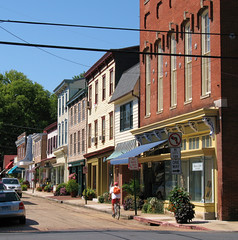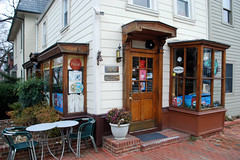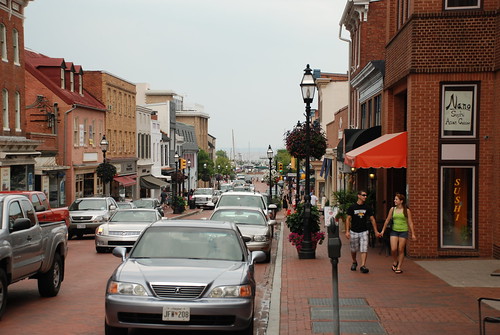A beginning agenda for making smart growth legal

Posted July 27, 2011 at 1:33PM
When then-governor Parris Glendening announced a key portion of what was to become Maryland’s path-breaking land use legislation in the 1990s, he stood in the historic district of Annapolis, where Maryland’s State House is located. He told the crowd that the best parts of downtown Annapolis – a picturesque, highly walkable and much-loved collection of 17th- and 18th-century homes, apartments, shops, civic and church buildings, restaurants and small offices just above the city’s harbor – could not have been built in the late 20th century.
Modern zoning and building codes wouldn’t allow it. There are too many uses mixed together, insufficient setbacks from the street, not enough parking, stairways that don’t meet modern building codes, streets too narrow, and so on. The implication was clear: there is something very wrong with a system of laws that has deviated so far from our intrinsic instincts that it has, perhaps unwittingly but nevertheless effectively, outlawed the very things that have made Maryland’s state capital so popular with residents and visitors.
 This blog is replete with great examples of more recent development that attempts to recapture some of the attributes that make historic districts so loved. We are pleased to celebrate these new examples of sustainability, places that make walking a viable option for going about one’s life, that shrink the footprint of development, conserving land and infrastructure.
This blog is replete with great examples of more recent development that attempts to recapture some of the attributes that make historic districts so loved. We are pleased to celebrate these new examples of sustainability, places that make walking a viable option for going about one’s life, that shrink the footprint of development, conserving land and infrastructure.
But, in almost every case, those exemplary new developments have required special exceptions from the building and zoning codes in effect in their municipalities. This has basically made sustainability much harder to build than sprawl, when our regulatory system should be doing just the opposite.
This brings me to a simple set of recommendations by “a roundtable of interested parties” constituted in Seattle. My friend Chuck Wolfe is a member of that roundtable, and he has very helpfully summarized the group's key findings in a post on the Seattle blog Crosscut. (Chuck also writes his own blog MyUrbanist, and we are both writers in The Sustainable Cities Collective.) The recommendations are not radical but, rather, all grounded in pragmatism and, if I may say so, common sense:
Encourage home entrepreneurship. Home-based businesses should be freely allowed so long as impacts to surrounding properties are minimized. I have to note that I am writing this blog from my home right now (it’s 10.30pm); I have no idea whether that is technically legal or not. The large government agency where my wife works has such an aggressive telecommuting program that some 80 percent of agency employees now work from their residences most of the time.  It’s time for our laws to catch up with reality, save the transportation energy and congestion associated with commuting, and allow people to work and serve customers from home again, as we did routinely for centuries.
It’s time for our laws to catch up with reality, save the transportation energy and congestion associated with commuting, and allow people to work and serve customers from home again, as we did routinely for centuries.
Concentrate street-level commercial uses in pedestrian zones. On this issue, Seattle’s current law is actually more progressive than most: street-level commercial uses have been required for some time in larger new buildings. The roundtable, working from experience, is recommending that the requirement become more nuanced and be made applicable primarily to buildings in designated pedestrian zones, not uniformly applied outside of those areas as well.
Enhance the flexibility of parking requirements. “As Seattle’s transit service improves, demand for on-site parking will shrink. This recommendation will allow the market to determine how much parking should be provided in locations within one quarter mile of good transit service (generally, those with at least 15 minute headways). It eliminates minimum parking requirements for residential or non-residential uses in such locations.” Personally, I might apply a nuanced approach here as well, with perhaps some limited minimum requirements for larger buildings that abut single-family residential areas. There doesn’t need to be an all-or-nothing approach, and we want neighbors to feel comfortable with nearby intensification where it makes sense.
 Allow small commercial uses in multifamily zones. This should be a no-brainer; bring back the corner store, please. The recommendation in Seattle is to allow small corner stores in two- and three-story multifamily zones in certain designated districts; the city already allows them in “mid-rise” and high-rise districts.
Allow small commercial uses in multifamily zones. This should be a no-brainer; bring back the corner store, please. The recommendation in Seattle is to allow small corner stores in two- and three-story multifamily zones in certain designated districts; the city already allows them in “mid-rise” and high-rise districts.
Expand options for accessory dwelling units. I believe accessory units – garage and basement apartments, “granny flats” and the like – should be allowed most everywhere. They allow a bit more density with very little change to the look and feel of a neighborhood. In this case, the roundtable is recommending expansion of Seattle’s excellent “backyard cottages” concept.
Allow mobile food vending and similar temporary uses. Another no-brainer. Food trucks and farmers’ markets are springing up everywhere in America. And it’s not exactly a radical idea: ever hear of the Good Humor man? But it some places it is restricted, common sense notwithstanding. (Reminds me of the recent local case in suburban DC where a kids’ lemonade stand set up outside the US Open Golf Tournament was shut down by the authorities. Jeez.)  In Seattle, the roundtable would allow vending carts on private property where other commercial uses are permitted and extend the permitted days and hours of farmers markets. Sounds like a baby step to me, but at least it’s in the right direction..
In Seattle, the roundtable would allow vending carts on private property where other commercial uses are permitted and extend the permitted days and hours of farmers markets. Sounds like a baby step to me, but at least it’s in the right direction..
Change state environmental law to obviate redundant review of projects. “The Roundtable recommended that the city take advantage of opportunities to streamline and combine SEPA review with other aspects of regulatory review for proposed residential and mixed-use projects in designated growth centers, such as urban centers and light rail station areas.” This one may be controversial with some of my environmental colleagues and partners, but the angel can be in the details – if, for example, the impacts of area plans have been reviewed, review of the same issues may not need to be repeated for projects that conform to those plans, especially in places where we have determined that growth should occur and where mitigation is built into the project. I don’t pretend to know the specifics of applicable city and state law in Seattle and how the recommendations would modify it, but I do think some degree of relaxation can be appropriate in designated growth centers, when the proposed project conforms to the desired types of growth as articulated in earlier legal documents.
As noted earlier in the post, these are hardly radical proposals. As my title suggests, they represent "beginning" steps. The real stunner is that our laws have become so contorted and restrictive that they are needed. The roundtable has done the citizens of Seattle a service by undertaking their study and making the recommendations, and Chuck as done us all a favor by spreading the word.
Move your cursor over the images for credit information.
